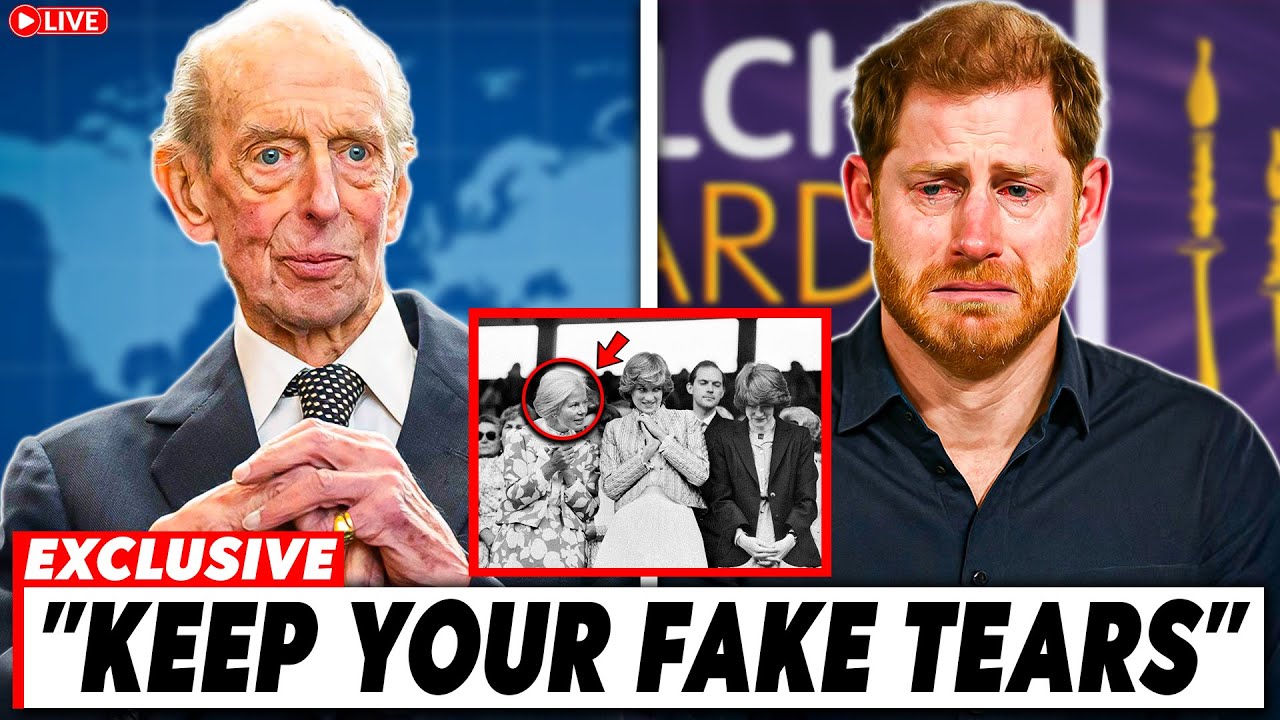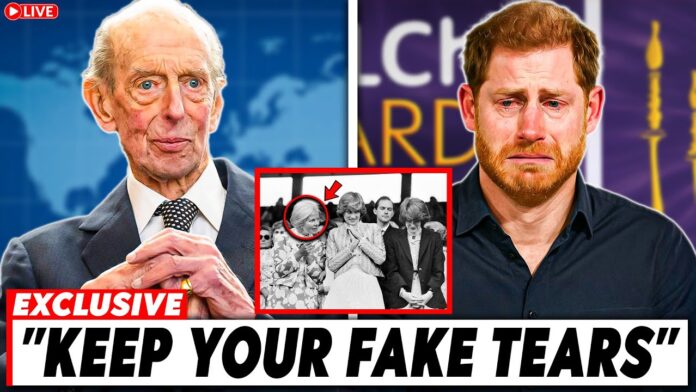😤 “YOU ARE NOT WELCOME!” – SHOCKING EXCLUSIVE: Duke of Kent IGNITES ROYAL WAR by GHOSTING Harry’s Desperate Condolence Email Over THIS Unforgivable Betrayal! 👑💥
Fresh from the haunting bagpipes at Westminster Cathedral, where the 89-year-old Duke of Kent buried his soulmate of 64 years, comes a gut-punch twist: Harry’s “heartfelt” email lands in the inbox… and gets ZERO response. Why the brutal snub? Insiders spill that the grieving widower sees it as yet another Sussex sideshow – a sneaky bid to rehab Harry’s image after skipping the funeral for Ukraine photo-ops and a cozy UK homecoming with Meghan. The Kents, raw from loss, aren’t buying the crocodile tears; one source fumes, “It’s the final insult – turning our private pain into his PR parade.” Harry’s camp swears it’s genuine outreach, but with the family rift wider than ever, this silent rejection screams volumes. Is this the nail in the coffin for any Sussex-Windsor thaw? The palace is buzzing, and fans are divided!

In the hushed aftermath of a requiem mass that blended ancient Catholic rites with the somber pomp of British monarchy, the echoes of Prince Harry’s condolence message to the Duke of Kent have met an unyielding silence. The email, dispatched in the wake of Katharine, Duchess of Kent’s funeral on September 16, 2025, was intended as a bridge across the chasm of royal estrangement. Instead, it has become emblematic of the fractures that continue to test the Windsor family’s resilience, with the 89-year-old duke – the monarchy’s elder statesman and a veteran of quiet endurance – opting for no reply at all. Palace observers, speaking on condition of anonymity, describe the non-response as a deliberate act of discretion, born not of pettiness but of profound personal grief compounded by years of perceived slights from the Duke of Sussex.
The funeral itself, held at Westminster Cathedral under the vaulted ceilings where cardinals and kings once sought solace, marked a historic departure for the House of Windsor. Katharine Worsley, who passed away on September 4 at the age of 92 in the familiar confines of Kensington Palace, was the first senior royal in modern times to receive a Catholic burial. Her conversion in 1994, a private epiphany that upended centuries of Anglican tradition, lent the service an air of quiet revolution. Cardinal Vincent Nichols, Archbishop of Westminster, led the proceedings, weaving Anglican hymns with Latin chants in a nod to the duchess’s dual spiritual heritage. A lone piper from the Royal Dragoon Guards – a regiment she championed as Deputy Colonel-in-Chief – played a haunting lament as her flag-draped coffin was borne by soldiers who had served under her husband’s command during his days leading the Scots Guards.
King Charles III, flanked by Queen Camilla, arrived in a motorcade that drew clusters of well-wishers along Victoria Street. Though undergoing ongoing treatment for cancer, the king appeared composed, his face a mask of regal solemnity as he entered the cathedral arm-in-arm with his wife. Prince William, the Prince of Wales, and Catherine, his wife, followed closely, their presence a bulwark of continuity for a family navigating multiple losses. Princess Anne, ever the stoic, sat in the front pew with her husband, Sir Timothy Laurence, while Prince Andrew, Duke of York, and his former wife, Sarah Ferguson, occupied seats further back – a reminder of the scandals that have reshaped attendance protocols. Notably absent was Prince Edward, Duke of Edinburgh, who was representing the crown at Expo 2025 in Osaka, Japan, alongside his wife, Sophie. His brother, Prince Michael of Kent, attended leaning on a cane, a poignant image of the aging cohort that once defined the queen’s extended family.
The Duke of Kent, Prince Edward George Nicholas Paul Patrick, stood at the epicenter of it all: frail in a dark suit, his hand trembling slightly as he clutched a program bearing his wife’s initials. At 89, he is now the oldest living member of the royal family, a distinction earned through a lifetime of understated service. Born in 1935 as the elder son of George, Duke of Kent – who perished in a 1942 plane crash – Edward ascended to his title at age seven. He walked behind his cousin, Queen Elizabeth II, in her 1953 coronation procession and served with distinction in the Far East, rising to colonel in the Royal Scots Greys. His marriage to Katharine in 1961, a union of Yorkshire gentry and royal blood, produced three children: George, Earl of St Andrews; Lady Helen Taylor; and Lord Nicholas Windsor. Yet, their family story is threaded with sorrow – the stillbirth of a son in 1977, which plunged Katharine into depression, and Nicholas’s own conversion to Catholicism in 2001, disqualifying him from the line of succession under pre-2013 rules.
Katharine herself was a figure of gentle nonconformity. The daughter of landed gentry, she met Edward at a 1956 dinner party and captivated him with her wit and independence. Their wedding at York Minster drew 26 reigning monarchs, but she chafed against the corseted expectations of royal life. In 2002, with the queen’s permission, she shed her HRH title, preferring the unadorned “Mrs. Kent.” She relocated to a modest flat in Hull, where she taught music to inner-city children for over a decade, including survivors of the 2017 Grenfell Tower disaster. “Music was her language of healing,” one former pupil recalled in a tribute published by The Times shortly after her death. At Wimbledon, where she presented trophies from 1978 onward, she became a beloved fixture, her empathy shining through in moments like consoling a tearful Jana Novotna after the 1993 final. Novotna’s 1998 victory, with the duchess in attendance, sealed a bond that transcended courtside pleasantries.
Health challenges shadowed her later years: chronic fatigue syndrome sidelined her from duties in 2004, and mobility issues confined her increasingly to Kensington Palace. Yet, her influence lingered. She advocated for dyslexia awareness through her daughter Helen and supported youth orchestras that brought classical music to underserved communities. Her death, announced by Buckingham Palace on September 5, prompted an outpouring from across the Commonwealth. Pope Leo XIV – the first American pontiff – issued a personal message of condolence, read during the mass by Apostolic Nuncio Archbishop Miguel Maury Buendia: “I send heartfelt condolences… especially to her husband, the Duke of Kent, and their children and grandchildren at this time of sorrow.” The king’s own tribute, delivered via video, lauded her “unwavering compassion and devotion to the arts.”
It was against this tapestry of remembrance that Prince Harry’s gesture arrived – or, more precisely, failed to land. The Duke of Sussex, 41, had been in Britain mere days before the funeral, fulfilling engagements at the WellChild Awards on September 8 and a brief reunion with his father at Clarence House. Their 45-minute meeting, described by a palace source as “cordial but constrained,” touched on family matters but yielded no public reconciliation. Harry then departed for Ukraine on September 9, promoting the Invictus Games amid the ongoing conflict, a trip that garnered international acclaim for its focus on wounded veterans. Meghan Markle, posting on Instagram on September 14, hinted at his return with a photo of rosé wine and the caption, “When your beau is back in town…” – a subtle nod to family time in California.
Harry did not attend the funeral, citing logistical challenges and his commitments abroad. In a statement to People magazine on September 15, a Sussex spokesperson confirmed: “The Duke of Sussex has sent condolences privately to the Duchess of Kent’s family following her death.” Details emerged post-service: the message, conveyed via email to the duke and his children, expressed sorrow for their loss and fond memories of Katharine’s kindness during his childhood. Yet, no acknowledgment has come from the Kent household. Aides close to the family, quoted in The Daily Mail on September 18, attribute the silence to a deeper weariness. “The duke is in the depths of mourning,” one said. “An email, however well-intentioned, feels like an intrusion when the wound is so fresh. And given the history – the public airing of grievances in Spare, the Oprah revelations – it’s hard to separate sincerity from strategy.”
The “history” looms large. Harry’s 2023 memoir painted raw portraits of royal dysfunction, including barbs at extended family members like Prince Andrew and Camilla. Though the Kents escaped direct mention, their proximity to the core family placed them in the crossfire. Insiders suggest the duke, a paragon of loyalty who has represented the queen on overseas tours and unveiled war memorials worldwide, views Harry’s interventions as opportunistic. His recent UK visit, timed with high-profile charity work, already drew skepticism: social media erupted with accusations of “grift,” amplified by posts on X (formerly Twitter) decrying the “email unanswered” saga. One viral thread, posted by @RoyalTweetsFam on September 9, queried: “Why Did the Duke of Kent Leave Prince Harry’s Email Unanswered?” It amassed hundreds of replies, many echoing sentiments like, “Loyalty means respecting boundaries – Harry’s crossed too many.”
This episode ripples through a monarchy in flux. King Charles, 76, balances health concerns with state duties, including hosting former U.S. President Donald Trump for a state banquet on September 17 – a diplomatic pivot amid transatlantic tensions. William and Catherine, fresh from their own cancer battles, have assumed greater visibility, their tour of Wales in early September underscoring a generational shift. Harry’s Ukraine advocacy, while noble, underscores his parallel path: the Archewell Foundation’s recent grants to mental health initiatives contrast with the Sussexes’ legal battles over security and media intrusions. Meghan’s lifestyle brand, with its sold-out rosé launch, signals entrepreneurial independence, yet fuels narratives of detachment from royal roots.
For the Kents, the silence is a shield. Lady Helen Taylor, 60, a jewelry designer and dyslexia campaigner, was seen escorting her father from the cathedral, her arm a steady anchor. George, 57, whose morganatic marriage barred him from succession, maintains a low profile in finance, while Nicholas, 45, navigates life post-conversion with his five children. The family’s statement post-funeral emphasized privacy: “Surrounded by her family, she slipped away peacefully… We ask for understanding as we grieve.” No mention of external messages, deliberate or otherwise.
As autumn leaves gather on the cathedral steps, the duke retreats to Wren House in Kensington Palace, where he and Katharine shared suppers and symphonies. His non-reply to Harry – if indeed an email was the medium – speaks to a man who has weathered Korea’s front lines and family tragedies without fanfare. Royal biographer Robert Lacey, in a BBC analysis on September 17, posited: “Edward’s generation prized duty over disclosure. In an era of tell-all tales, silence is his sharpest retort.” Harry’s team, undeterred, hints at future outreach, but the calculus has shifted. With Charles’s health in focus and William’s heir, Prince George, approaching 12, the monarchy eyes inward healing over outward drama.
Katharine’s legacy, meanwhile, blooms in unexpected places: a Hull schoolyard where her piano lessons echo, or Wimbledon’s Centre Court, where a new trophy engraving honors her grace. As the Book of Common Prayer – adapted for the mass – intoned, “In the midst of life we are in death.” For the Windsors, that midst now includes unanswered emails and unspoken wounds, a requiem not just for a duchess, but for the illusions of unbreakable bonds. The duke’s quiet snub, brutal in its brevity, reminds us: some condolences, like some rifts, are best left unread.
